“Takes no nerve to do something, ain’t nothin’ else you can do.”
– Tom, The Grapes of Wrath
Buenos Aires – As many of you have noted, sometimes my “themes” for Casa SaltShaker menus seem to have little to do with food. But come on, the movie Grapes of Wrath… that’s food, right? Grapes! Just because no one in the book/film had any food is no reason it can’t inspire me. A menu based on grapes to celebrate the release of the film… in 1940. One of the things that’s interesting when I’ve proposed menus that are focused on a particular ingredient is the reaction to the idea of a “single item” menu. I received several queries in advance from people sort of hinting that they weren’t so sure they wanted to come after all given that they were just going to have grapes piled on plate after plate. (The same thing happened way back with our early on chocolate menu.) What gets forgotten is that ingredients come in many forms. Grapes come in different varieties, plus raisins, wine, grappa, brandy, verjus, juice, powders, and that’s just off the top of my head. Just wait until you see the upcoming tomato menu!
So, not to worry, even though some did. We ended up open three nights this weekend after getting a request from an online friend in Brasil to accomodate he and his family, a party of eight – sufficient to justify opening an extra night, and while we quickly filled the other four spots, two folks cancelled at the last minute – this seems to be happening a lot this month – last minute cancellations and no-shows, something that never happened before – and I’m getting the same thing I used to get in NYC – “oh, we made reservations at several places and decided to go to this one” – while a minor issue for many restaurants, for us, with only twelve seats and no walk-in trade, a problem, since we’ve already bought and cooked the food for the people who don’t show up. More of folks not understanding what it is we’re doing – despite my explanations to them, and pleas to look at the website and get a sense of what we do, the vast majority of folks who’ve come this month seem to be completely surprised by the fact that they’re in a home and not a restaurant. Many people simply don’t read the information in front of them. Such is life, I guess.
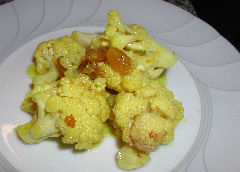 Last week’s fennel escabeche was such a hit that I decided to play around with it a bit more. I had in mind an idea for a cold salad that I’ve tried before, of grilled cauliflower served in a raisin and almond dressing. I decided to take those flavors and make an escabeche instead. The first night I sauteed the caulilflower in olive oil with garlic, ground almonds, and yellow raisins. For spices, I went a middle eastern route, with a mix of coriander, cumin, turmeric, and a hint of pepper. For the acid, I used grapefruit juice and grapefruit rind. It came out okay, but not with the punch that I wanted. First, I used too much turmeric trying to get a vivid yellow color, and it developed a slightly bitter finish to the dish. Second, the grapefruit was a little too aggressive. Third, the dish was indeed a vivid yellow, but perhaps too much so.
Last week’s fennel escabeche was such a hit that I decided to play around with it a bit more. I had in mind an idea for a cold salad that I’ve tried before, of grilled cauliflower served in a raisin and almond dressing. I decided to take those flavors and make an escabeche instead. The first night I sauteed the caulilflower in olive oil with garlic, ground almonds, and yellow raisins. For spices, I went a middle eastern route, with a mix of coriander, cumin, turmeric, and a hint of pepper. For the acid, I used grapefruit juice and grapefruit rind. It came out okay, but not with the punch that I wanted. First, I used too much turmeric trying to get a vivid yellow color, and it developed a slightly bitter finish to the dish. Second, the grapefruit was a little too aggressive. Third, the dish was indeed a vivid yellow, but perhaps too much so. 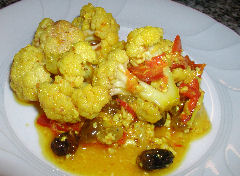 So for the second and third nights I added color in the form of some thinly slivered red bell pepper, and changing the raisins to a mix of yellow and black. I tamed the grapefruit juice with the addition of some orange juice, about 2:1. And I cut way back on the turmeric, removed the yellow pepper, and added a little powdered saffron. That actually punched the color up more than the turmeric alone, gave more complexity to the dish. I also made sure there was more juice and olive oil so that the cauliflower wasn’t simply coated, but actually had a bit of the escabeche sauce on the plate. This was the dish I imagined in the first place.
So for the second and third nights I added color in the form of some thinly slivered red bell pepper, and changing the raisins to a mix of yellow and black. I tamed the grapefruit juice with the addition of some orange juice, about 2:1. And I cut way back on the turmeric, removed the yellow pepper, and added a little powdered saffron. That actually punched the color up more than the turmeric alone, gave more complexity to the dish. I also made sure there was more juice and olive oil so that the cauliflower wasn’t simply coated, but actually had a bit of the escabeche sauce on the plate. This was the dish I imagined in the first place.
This, by the way, brings up an answer to a question I often get asked… “is it better if we come the first night or the second night of a menu?” That’s a tough question to answer. In general, I’d say that my presentation of dishes improves the second night. However, I also tend to change dishes a bit based on things that I’m not necessarily happy with the first night. Sometimes that works, sometimes it doesn’t, and it’s probably not far off of an even split, especially if the first night’s recipe is based on something I’ve done before, or on a tried and true classic. There are reasons that dishes work time and again – people have experimented over and over. Sometimes, making a change, even when you’ve got the experience, simply doesn’t work. And truly, a lot of the Casa S experience comes down to the mix of the people who come. Thursday night, we had the family of eight, mixed Brasilian and Argentine, and an Argentine couple sitting on their own at the other table. The family group had a great reunion, the couple, while enjoying the food, spent the evening in quiet conversation. Friday night, another party of eight, a birthday party for a local expat along with her local and visiting friends, the other table, two couples who hit if off well, and a lively evening had by all. Last night, one group of four, and the rest couples – three of whom just happened to be on their honeymoons. People mixing and matching, indeed, the group of four split between the two tables, all visiting norteamericanos (and one Brasilian), conversation back and forth between the tables, and folks stayed until the wee hours chatting, exchanging addresses and e-mails, and even arranging to spend time together over the next week or two of their visits. We simply never know…
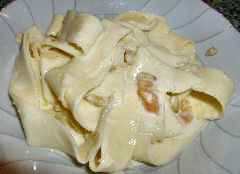 This dish is deceivingly simple looking. It’s also a dish that for me, could make living as a vegetarian plausible (I’ve tried before, really, it’s just not me). It’s based on a traditional Amalfi coast pasta sauce of lemon and grappa, but taken to a different place. My usual pasta maker is on vacation (there are some pastas I make, and some that it’s truly better if I buy from someone professional who makes them daily) – so I used dry pappardelle, but went for good quality, of course. This dish would be up another notch with fresh pasta… The sauce is lemony. Really lemony. Now, remember I’m making pasta for twelve as a mid-course – so figure on for six as a main course. Take four lemons. Remove just the outer yellow skin and sliver it very finely (the first night I grated it, but it disappeared into the sauce, and I like it better when it’s visible). Juice two of the lemons. The other two, remove all the white pith, then remove the flesh from the membrane that surrounds them, remove the seeds, and finely chop the flesh. Reconstitute dried peaches in a little boiling water and finely dice. Toast some pinenuts. You’re ready. While the pasta is cooking, gently warm three cups of cream, one cup of grappa, the lemon flesh and slivered rind, salt, and a little white pepper until it just thickens slightly (essentially you’re souring the cream). At the last moment before you add the pasta to the sauce, toss in the pinenuts, the chopped peaches (apricots work well too), and the lemon juice. Adjust the salt and white pepper seasoning and toss with the pasta. Did I mention this is very lemony?
This dish is deceivingly simple looking. It’s also a dish that for me, could make living as a vegetarian plausible (I’ve tried before, really, it’s just not me). It’s based on a traditional Amalfi coast pasta sauce of lemon and grappa, but taken to a different place. My usual pasta maker is on vacation (there are some pastas I make, and some that it’s truly better if I buy from someone professional who makes them daily) – so I used dry pappardelle, but went for good quality, of course. This dish would be up another notch with fresh pasta… The sauce is lemony. Really lemony. Now, remember I’m making pasta for twelve as a mid-course – so figure on for six as a main course. Take four lemons. Remove just the outer yellow skin and sliver it very finely (the first night I grated it, but it disappeared into the sauce, and I like it better when it’s visible). Juice two of the lemons. The other two, remove all the white pith, then remove the flesh from the membrane that surrounds them, remove the seeds, and finely chop the flesh. Reconstitute dried peaches in a little boiling water and finely dice. Toast some pinenuts. You’re ready. While the pasta is cooking, gently warm three cups of cream, one cup of grappa, the lemon flesh and slivered rind, salt, and a little white pepper until it just thickens slightly (essentially you’re souring the cream). At the last moment before you add the pasta to the sauce, toss in the pinenuts, the chopped peaches (apricots work well too), and the lemon juice. Adjust the salt and white pepper seasoning and toss with the pasta. Did I mention this is very lemony?
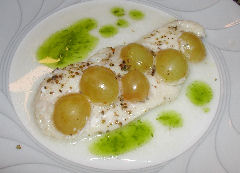 While in some ways the most grapey of the dishes on the menu, except perhaps dessert, the Sole Veronique was the least interesting to me. I think I’d almost rather have repeated the Marguery dish we offered back in August – more complex, more flavorful, more interesting. I suppose there’s something to be said for a delicately flavored dish like this, but perhaps not as part of a dinner with all the other intense flavors going on. Simply, this is sole, or flounder, steamed in packets with a little dry vermouth and grapes. I added a touch of marjoram to the mix. I served it with the sauce from steaming and garnished with a little chive oil. On the other hand, the Marguery has almonds, butter, marsala, and lemon zest… for me, no contest if I was to repeat a similar dish on a menu.
While in some ways the most grapey of the dishes on the menu, except perhaps dessert, the Sole Veronique was the least interesting to me. I think I’d almost rather have repeated the Marguery dish we offered back in August – more complex, more flavorful, more interesting. I suppose there’s something to be said for a delicately flavored dish like this, but perhaps not as part of a dinner with all the other intense flavors going on. Simply, this is sole, or flounder, steamed in packets with a little dry vermouth and grapes. I added a touch of marjoram to the mix. I served it with the sauce from steaming and garnished with a little chive oil. On the other hand, the Marguery has almonds, butter, marsala, and lemon zest… for me, no contest if I was to repeat a similar dish on a menu.
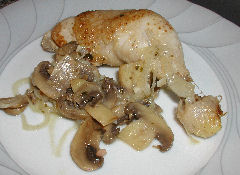 Another dish that underwent a transformation between the nights, though this one really just in presentation. A few months back, the New York Times published a recipe called Coq au Riesling – a chicken stewed in a Riesling broth that sounded absolutely delicious. I didn’t make much in the way of changes other than the way it was presented, and using wine made from the local Torrontés grape rather than Riesling – both aromatic styled wines. I first sauteed some finely diced smoked bacon until it rendered out a bit of fat, than sauteed a mix of different onions – white, yellow, red – in the fat until limp and translucent. I removed the onion mixture and set it aside, then browned the chicken pieces on both sides. After browning, I set them aside, and added a large amount of sliced mushrooms, and lots of chopped garlic, to the pan, and sauteed until the mushrooms were just starting to release their juices.
Another dish that underwent a transformation between the nights, though this one really just in presentation. A few months back, the New York Times published a recipe called Coq au Riesling – a chicken stewed in a Riesling broth that sounded absolutely delicious. I didn’t make much in the way of changes other than the way it was presented, and using wine made from the local Torrontés grape rather than Riesling – both aromatic styled wines. I first sauteed some finely diced smoked bacon until it rendered out a bit of fat, than sauteed a mix of different onions – white, yellow, red – in the fat until limp and translucent. I removed the onion mixture and set it aside, then browned the chicken pieces on both sides. After browning, I set them aside, and added a large amount of sliced mushrooms, and lots of chopped garlic, to the pan, and sauteed until the mushrooms were just starting to release their juices. 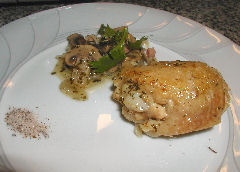 Then I added the mushroom mixture back to the pan, salt, black pepper, chopped parsley and tarragon (I tried both ways, dried herbs actually work better in this dish – more intense flavor). Then the chicken was layered on top of this mixture, a bottle of Torrontés poured over it all, brought to a boil, then the heat reduced to minimum, and covered the pan. It simmers away for about an hour and a half, until the chicken is done. Rather than serve atop rice with all the broth, or as a stew, I drained off most of the liquid and presented the mushroom, onion, and bacon mix alongside the chicken (which the first night I served a leg/thigh combination, but it was too much food, the second and third nights just a thigh, and browned darker), topped with a little fresh parsley and garnished with a little pile of mushroom salt.
Then I added the mushroom mixture back to the pan, salt, black pepper, chopped parsley and tarragon (I tried both ways, dried herbs actually work better in this dish – more intense flavor). Then the chicken was layered on top of this mixture, a bottle of Torrontés poured over it all, brought to a boil, then the heat reduced to minimum, and covered the pan. It simmers away for about an hour and a half, until the chicken is done. Rather than serve atop rice with all the broth, or as a stew, I drained off most of the liquid and presented the mushroom, onion, and bacon mix alongside the chicken (which the first night I served a leg/thigh combination, but it was too much food, the second and third nights just a thigh, and browned darker), topped with a little fresh parsley and garnished with a little pile of mushroom salt.
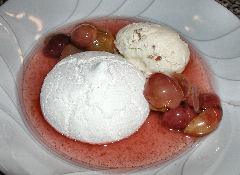 And finally, a bit more of a change. Initially I’d envision a genoise cake, fill it with a grape compote, and garnish it with a little “black grape foam”. The genoise flopped completely – I think a combination of the high humidity the last couple of days and just bad luck. Not having time to make another cake, and figuring it might come out the same, I fudged a bit, ran to the corner panadería, intent on finding a nice little pound cake or something that I could serve – after all, the features were really the grape compote and foam. They had nothing available except these meringues.
And finally, a bit more of a change. Initially I’d envision a genoise cake, fill it with a grape compote, and garnish it with a little “black grape foam”. The genoise flopped completely – I think a combination of the high humidity the last couple of days and just bad luck. Not having time to make another cake, and figuring it might come out the same, I fudged a bit, ran to the corner panadería, intent on finding a nice little pound cake or something that I could serve – after all, the features were really the grape compote and foam. They had nothing available except these meringues. 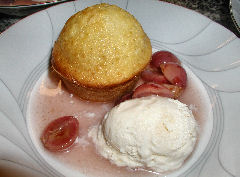 Not one of my favorite things, but, necessity and all that – I grabbed the merengues and used them. The following nights, rather than that, I played around with a classic whole egg white cake recipe that, made into cupcakes, worked for presentation, and was delicious! The cupcake was a quick and easy beaten mixture of 2½ cups + 2 tablespoons of cake flour, 1½ cups sugar, 3½ teaspoons of baking powder, 1 teaspoon salt – all sifted together, then mixed with ½ cup of melted butter, 1 cup of milk, 1 teaspoon of vanilla, and 3 eggs. Baked in muffin tins… and voila!
Not one of my favorite things, but, necessity and all that – I grabbed the merengues and used them. The following nights, rather than that, I played around with a classic whole egg white cake recipe that, made into cupcakes, worked for presentation, and was delicious! The cupcake was a quick and easy beaten mixture of 2½ cups + 2 tablespoons of cake flour, 1½ cups sugar, 3½ teaspoons of baking powder, 1 teaspoon salt – all sifted together, then mixed with ½ cup of melted butter, 1 cup of milk, 1 teaspoon of vanilla, and 3 eggs. Baked in muffin tins… and voila!
The grape compote was a simple mixture of equal parts by volume of seeded black grapes, sugar, and sweet wine, along with the zest of a couple of lemons and a bit of five-spice powder – all simmered together until the grapes were soft, then cooled and chilled. The “black grape foam” started out with a recipe from Mario Batali that involved juicing black grapes along with a bit of their pulp, sugar, water, lemon zest and mixing that with sweeteened whippped cream and sugar – all processed in an ice cream maker and frozen in dixie cups… It came out the right flavors, but I though the bits of pulp were a little odd. The following nights I used just grape juice, with no pulp or skins, no lemon zest, and no extra water, and mixed that with the sweetened whipped cream. I though the texture came out creamier and smoother, and liked the result much more.
On the wine front, the most interesting, we tried two different red wines with out wine pairings on Friday and Saturday night, and it’s a tossup which I liked better with the chicken. The first was the Bodegas Callia Magna Tannat 2005, a rich, but smooth tannined version of Tannat from the San Juan region of Argentina. Big and bold, but with lots of spice, it might almost have been a touch too much for the chicken, but everyone seemed to love it. On Saturday I decided to lighten it up a little, and tried out the NQN Picada 15 2005, a blend of Pinot Noir and Cabernet Sauvignon from Patagonia – spicy, bright, all sorts of complex flavors, and medium bodied. I personally thought it was a spectacular match, and a delicious wine all on its own.
[…] favorite here. I went with a somewhat middle eastern flair to it, going with my now well practiced Cauliflower Escabeche with no changes – even the photo looked more or less the same… and it was received well by […]
[…] rind and flesh, toasted pinenuts, and soft, dried apricots in place of the peaches I used in the original iteration. A hint of chili thrown into the mix, I think it could even be upped a […]